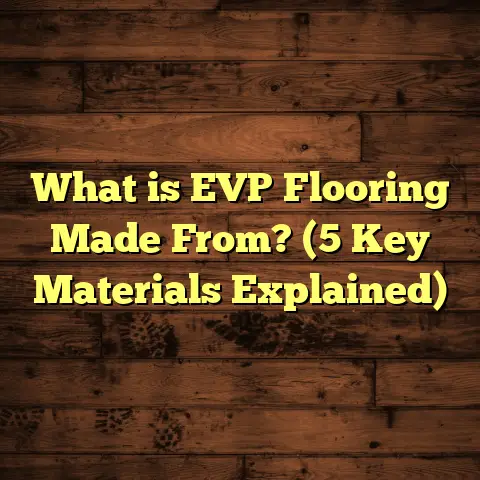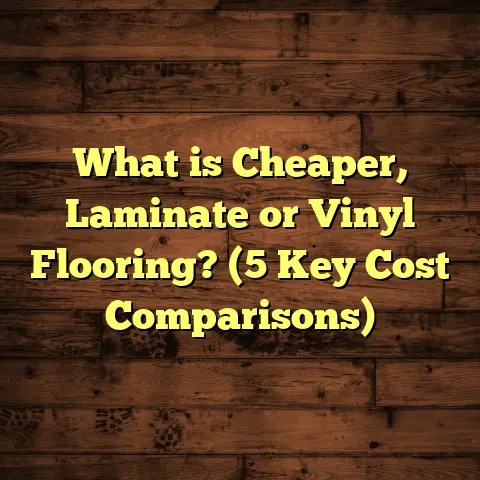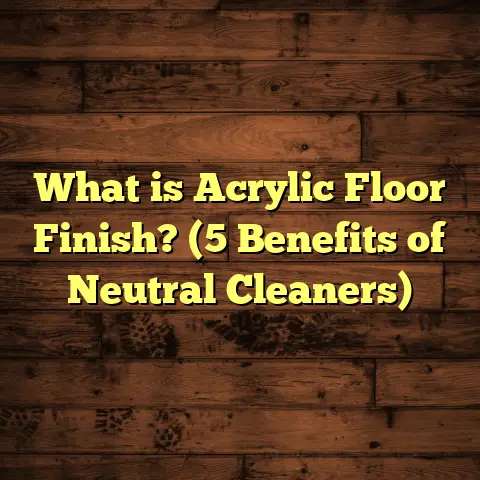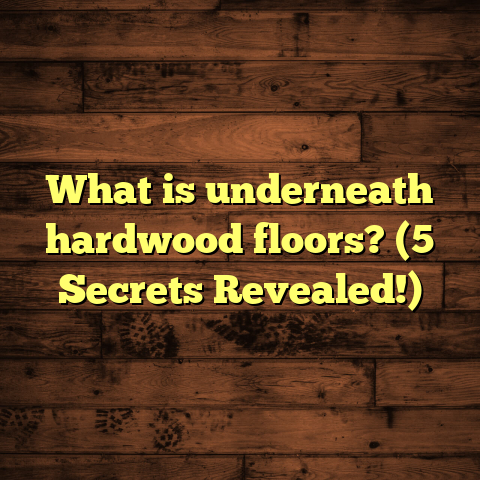What is Parquet Flooring? (5 Benefits You Didn’t Know About)
I remember when I first took on a home renovation
project and faced a big challenge: finding the perfect
flooring that combined beauty, durability, and a bit
of character. I wanted something unique—something
that would make my space stand out without being
overly flashy. That’s when I stumbled upon parquet
flooring. At first, I wasn’t even sure what it was, but
after some digging and hands-on experience, I realized
how much this type of flooring could offer.
What is Parquet Flooring?
Parquet flooring is a type of wood flooring made from
small blocks or strips of hardwood arranged in distinct,
geometric patterns. Unlike traditional hardwood planks
that run in straight lines, parquet focuses on artistry
and design. The pieces are often laid in patterns like
herringbone, chevron, basket weave, or mosaic designs,
which add a rich texture and visual interest to any room.
The word “parquet” comes from the French word parchet,
meaning a small compartment or enclosed area, which fits
perfectly since each small block fits together like pieces
of a puzzle. The wood used in parquet can be oak, walnut,
cherry, maple, or exotic species, depending on the desired
look and budget.
A Little History
Parquet flooring has roots going back to the 17th century
when it was used in the palaces of Europe, especially France.
It was an alternative to marble floors, which were harder to
maintain. Over time, parquet became popular in residential
homes because it brought elegance without the upkeep
marble demanded.
I recall visiting a 19th-century mansion where the original
parquet floors had survived more than 150 years. The owner
had lovingly maintained them with periodic refinishing. It was
amazing to see how the geometric wood patterns preserved the
character and charm of that era while still feeling warm and
inviting.
The 5 Benefits of Parquet Flooring You Didn’t Know About
You might think parquet flooring is just about looks. But here’s
what I’ve discovered after working with it for years:
1. Durability with Style
Parquet floors are made from solid hardwood or engineered wood
with hardwood veneers. This means they are not only beautiful but
built to last. Hardwood naturally resists wear and tear better than
many other flooring materials.
In fact, studies show that hardwood floors can last upwards of 30
years or more with proper care. Parquet’s design allows for multiple
layers of wood to be glued together in engineered versions, which adds
strength and stability. This makes parquet flooring less prone to warping
or swelling compared to traditional hardwood in humid environments.
From my experience installing parquet in several homes near coastal areas,
I found that engineered parquet handled moisture fluctuations much better
than standard planks. One client living near the ocean told me their floors had
remained flawless despite the salty air and humidity — something that often ruins
other wood floors quickly.
Plus, the geometric design distributes weight and pressure differently than planks. This means high-traffic areas tend to show less visible wear.
2. Eco-Friendly Choice
If you care about sustainability, parquet flooring can be a great option. Many manufacturers source their wood from responsibly managed forests certified by organizations like FSC (Forest Stewardship Council). Also, since parquet uses smaller pieces of wood, it often utilizes offcuts and wood pieces that might otherwise go to waste.
One project I worked on involved using reclaimed wood parquet blocks. Not only did this reduce waste, but it gave the floor a unique character with natural imperfections and a story behind every plank.
Some companies specialize in recycled parquet made from salvaged wood from old buildings — helping reduce deforestation and landfill waste. When you choose this kind of parquet, you’re supporting environmentally conscious practices while getting an authentic vintage look.
3. Easy Repair and Maintenance
Have you ever had a scratch on your hardwood floor that seemed impossible to fix? Parquet floors can be easier to repair because you can replace individual blocks instead of needing to refinish an entire floor.
For example, when a client’s dog scratched their parquet floor, we simply swapped out the damaged blocks rather than sanding down the whole surface. This localized repair saved time and money.
Routine maintenance is straightforward — regular sweeping or vacuuming and occasional mopping with wood-friendly cleaners keep parquet floors looking fresh. Plus, their pattern tends to hide minor scratches better than plain planks.
Here’s a little tip that I share often: Avoid harsh chemical cleaners or steam mops on parquet floors since they can damage the wood finish over time. Instead, use pH-neutral hardwood floor cleaners.
I remember advising an elderly client who was worried about maintaining her beautiful parquet floors. By setting up a simple cleaning schedule with gentle products and protective pads under furniture legs, she kept her floors looking new for years without hassle.
4. Adds Value and Style to Your Home
From a real estate perspective, parquet flooring often adds significant value to a home. According to a survey by the National Wood Flooring Association (NWFA), homes with hardwood floors sell faster and for more money on average than those without.
Parquet’s unique patterns create an upscale feel that appeals to buyers looking for something special. In my own home renovation projects, clients often comment on how the parquet floor becomes a conversation piece for visitors.
Stylistically, parquet works well with both traditional and modern interiors. Whether your home has vintage charm or sleek minimalism, there’s a parquet pattern and wood tone that fits.
I once helped a family pick out parquet flooring for their new urban loft. They wanted something warm but modern — we chose a light oak herringbone pattern that complemented their industrial decor perfectly. Months later they told me how many compliments they’d received from friends.
5. Improves Indoor Air Quality
This might surprise you: parquet flooring can actually help improve indoor air quality compared to carpets or some synthetic flooring types.
Carpets tend to trap dust, allergens, and pet dander — requiring frequent deep cleaning. In contrast, wooden surfaces like parquet are easier to clean thoroughly and do not harbor allergens as much.
A study published by the American Lung Association found that homes with hardwood floors reported fewer allergy symptoms compared to carpeted homes. If allergies are a concern for you or your family members, parquet flooring could be a healthier option.
I have clients with asthma who specifically request hardwood or parquet floors because they notice less sneezing and congestion after switching from carpeted rooms.
Exploring Different Parquet Patterns
One thing that makes parquet truly special is the variety of patterns available — each bringing its own personality to a space.
Herringbone
Herringbone is probably the most popular parquet pattern. It features rectangular blocks arranged in a zigzag pattern resembling fish bones (hence the name). This pattern adds movement and depth without being overwhelming.
I installed herringbone floors in a modern kitchen recently where the pattern helped break up large open spaces while keeping things elegant and clean.
Chevron
Chevron looks similar to herringbone but has angled ends on each block so the pieces meet at sharp points forming continuous V shapes. It’s bolder than herringbone and creates more dramatic lines.
A client wanted chevron floors in their dining room for an artistic statement — it gave the room energy while keeping natural wood warmth.
Basket Weave
Basket weave consists of rectangular blocks arranged in pairs at right angles creating square “baskets.” It’s classic and works well in traditional or rustic interiors.
I remember restoring basket weave parquet in an old farmhouse kitchen. It was worn but after refinishing it looked timeless — perfect for that cozy setting.
Versailles
Versailles pattern is more elaborate with squares containing smaller geometric shapes inside them often bordered by strips — this style is inspired by French palaces.
I installed Versailles parquet in a luxury condo where clients wanted something regal yet approachable — it definitely made guests stop and admire the detailing.
My Personal Story with Parquet Flooring
When I first started as a flooring contractor over 15 years ago, I was mostly installing traditional hardwood planks. One day I got called to restore an old Victorian home where hidden under layers of carpet was original parquet flooring.
It was covered in dirt and scratches but I could see potential beneath all that grime. After sanding and refinishing for days, the floor came back to life with intricate patterns telling stories of craftsmanship from long ago.
That job changed how I viewed flooring — it wasn’t just about covering floors but about preserving history and adding personality through design choices like parquet.
Since then I’ve specialized more in parquet installations and restorations because these floors offer something special: character, durability, style — all wrapped up in one package.
Installation: What You Should Know Before You Start
Installing parquet flooring isn’t quite like laying down regular hardwood planks. It requires precise measuring, cutting, and fitting because each small piece must align perfectly to form patterns.
Here are some tips based on my experience:
- Subfloor Prep: The surface must be level and clean before starting; any bumps will show through.
- Acclimate Materials: Wood should be stored on site for at least 48 hours before installation so it adjusts to room temperature and humidity.
- Adhesives Matter: Use high-quality glue designed for wood flooring; this ensures long-lasting adhesion.
- Professional Help: Because precision is key here, I usually recommend hiring an experienced installer unless you have advanced DIY skills.
- Pattern Layout: Start from the center or focal point of the room for balanced symmetry.
- Expansion Gaps: Leave appropriate gaps around edges for natural expansion due I remember when I first took on a home renovation
project and faced a big challenge: finding the perfect
flooring that combined beauty, durability, and a bit
of character. I wanted something unique—something
that would make my space stand out without being
overly flashy. That’s when I stumbled upon parquet
flooring. At first, I wasn’t even sure what it was, but
after some digging and hands-on experience, I realized
how much this type of flooring could offer.
What is Parquet Flooring?
Parquet flooring is a type of wood flooring made from
small blocks or strips of hardwood arranged in distinct,
geometric patterns. Unlike traditional hardwood planks
that run in straight lines, parquet focuses on artistry
and design. The pieces are often laid in patterns like
herringbone, chevron, basket weave, or mosaic designs,
which add a rich texture and visual interest to any room.
The word “parquet” comes from the French word parchet,
meaning a small compartment or enclosed area, which fits
perfectly since each small block fits together like pieces
of a puzzle. The wood used in parquet can be oak, walnut,
cherry, maple, or exotic species, depending on the desired
look and budget.
A Little History
Parquet flooring has roots going back to the 17th century
when it was used in the palaces of Europe, especially France.
It was an alternative to marble floors, which were harder to
maintain. Over time, parquet became popular in residential
homes because it brought elegance without the upkeep
marble demanded.
I recall visiting a 19th-century mansion where the original
parquet floors had survived more than 150 years. The owner
had lovingly maintained them with periodic refinishing. It was
amazing to see how the geometric wood patterns preserved the
character and charm of that era while still feeling warm and
inviting.
The 5 Benefits of Parquet Flooring You Didn’t Know About
You might think parquet flooring is just about looks. But here’s
what I’ve discovered after working with it for years:
1. Durability with Style
Parquet floors are made from solid hardwood or engineered wood
with hardwood veneers. This means they are not only beautiful but
built to last. Hardwood naturally resists wear and tear better than
many other flooring materials.
In fact, studies show that hardwood floors can last upwards of 30
years or more with proper care. Parquet’s design allows for multiple
layers of wood to be glued together in engineered versions, which adds
strength and stability. This makes parquet flooring less prone to warping
or swelling compared to traditional hardwood in humid environments.
From my experience installing parquet in several homes near coastal areas,
I found that engineered parquet handled moisture fluctuations much better
than standard planks. One client living near the ocean told me their floors had
remained flawless despite the salty air and humidity — something that often ruins
other wood floors quickly.
Plus, the geometric design distributes weight and pressure differently than planks. This means high-traffic areas tend to show less visible wear.
2. Eco-Friendly Choice
If you care about sustainability, parquet flooring can be a great option. Many manufacturers source their wood from responsibly managed forests certified by organizations like FSC (Forest Stewardship Council). Also, since parquet uses smaller pieces of wood, it often utilizes offcuts and wood pieces that might otherwise go to waste.
One project I worked on involved using reclaimed wood parquet blocks. Not only did this reduce waste, but it gave the floor a unique character with natural imperfections and a story behind every plank.
Some companies specialize in recycled parquet made from salvaged wood from old buildings — helping reduce deforestation and landfill waste. When you choose this kind of parquet, you’re supporting environmentally conscious practices while getting an authentic vintage look.
3. Easy Repair and Maintenance
Have you ever had a scratch on your hardwood floor that seemed impossible to fix? Parquet floors can be easier to repair because you can replace individual blocks instead of needing to refinish an entire floor.
For example, when a client’s dog scratched their parquet floor, we simply swapped out the damaged blocks rather than sanding down the whole surface. This localized repair saved time and money.
Routine maintenance is straightforward — regular sweeping or vacuuming and occasional mopping with wood-friendly cleaners keep parquet floors looking fresh. Plus, their pattern tends to hide minor scratches better than plain planks.
Here’s a little tip that I share often: Avoid harsh chemical cleaners or steam mops on parquet floors since they can damage the wood finish over time. Instead, use pH-neutral hardwood floor cleaners.
I remember advising an elderly client who was worried about maintaining her beautiful parquet floors. By setting up a simple cleaning schedule with gentle products and protective pads under furniture legs, she kept her floors looking new for years without hassle.
4. Adds Value and Style to Your Home
From a real estate perspective, parquet flooring often adds significant value to a home. According to a survey by the National Wood Flooring Association (NWFA), homes with hardwood floors sell faster and for more money on average than those without.
Parquet’s unique patterns create an upscale feel that appeals to buyers looking for something special. In my own home renovation projects, clients often comment on how the parquet floor becomes a conversation piece for visitors.
Stylistically, parquet works well with both traditional and modern interiors. Whether your home has vintage charm or sleek minimalism, there’s a parquet pattern and wood tone that fits.
I once helped a family pick out parquet flooring for their new urban loft. They wanted something warm but modern — we chose a light oak herringbone pattern that complemented their industrial decor perfectly. Months later they told me how many compliments they’d received from friends.
5. Improves Indoor Air Quality
This might surprise you: parquet flooring can actually help improve indoor air quality compared to carpets or some synthetic flooring types.
Carpets tend to trap dust, allergens, and pet dander — requiring frequent deep cleaning. In contrast, wooden surfaces like parquet are easier to clean thoroughly and do not harbor allergens as much.
A study published by the American Lung Association found that homes with hardwood floors reported fewer allergy symptoms compared to carpeted homes. If allergies are a concern for you or your family members, parquet flooring could be a healthier option.
I have clients with asthma who specifically request hardwood or parquet floors because they notice less sneezing and congestion after switching from carpeted rooms.
Exploring Different Parquet Patterns
One thing that makes parquet truly special is the variety of patterns available — each bringing its own personality to a space.
Herringbone
Herringbone is probably the most popular parquet pattern. It features rectangular blocks arranged in a zigzag pattern resembling fish bones (hence the name). This pattern adds movement and depth without being overwhelming.
I installed herringbone floors in a modern kitchen recently where the pattern helped break up large open spaces while keeping things elegant and clean.
Chevron
Chevron looks similar to herringbone but has angled ends on each block so the pieces meet at sharp points forming continuous V shapes. It’s bolder than herringbone and creates more dramatic lines.
A client wanted chevron floors in their dining room for an artistic statement — it gave the room energy while keeping natural wood warmth.
Basket Weave
Basket weave consists of rectangular blocks arranged in pairs at right angles creating square “baskets.” It’s classic and works well in traditional or rustic interiors.
I remember restoring basket weave parquet in an old farmhouse kitchen. It was worn but after refinishing it looked timeless — perfect for that cozy setting.
Versailles
Versailles pattern is more elaborate with squares containing smaller geometric shapes inside them often bordered by strips — this style is inspired by French palaces.
I installed Versailles parquet in a luxury condo where clients wanted something regal yet approachable — it definitely made guests stop and admire the detailing.
My Personal Story with Parquet Flooring
When I first started as a flooring contractor over 15 years ago, I was mostly installing traditional hardwood planks. One day I got called to restore an old Victorian home where hidden under layers of carpet was original parquet flooring.
It was covered in dirt and scratches but I could see potential beneath all that grime. After sanding and refinishing for days, the floor came back to life with intricate patterns telling stories of craftsmanship from long ago.
That job changed how I viewed flooring — it wasn’t just about covering floors but about preserving history and adding personality through design choices like parquet.
Since then I’ve specialized more in parquet installations and restorations because these floors offer something special: character, durability, style — all wrapped up in one package.
Installation: What You Should Know Before You Start
Installing parquet flooring isn’t quite like laying down regular hardwood planks. It requires precise measuring, cutting, and fitting because each small piece must align perfectly to form patterns.
Here are some tips based on my experience:
- Subfloor Prep: The surface must be level and clean before starting; any bumps will show through.
- Acclimate Materials: Wood should be stored on site for at least 48 hours before installation so it adjusts to room temperature and humidity.
- Adhesives Matter: Use high-quality glue designed for wood flooring; this ensures long-lasting adhesion.
- Professional Help: Because precision is key here, I usually recommend hiring an experienced installer unless you have advanced DIY skills.
- Pattern Layout: Start from the center or focal point of the room for balanced symmetry.
- Expansion Gaps: Leave appropriate gaps around edges for natural expansion based on manufacturer recommendations (usually about 1/4 inch).
One time I watched an amateur installer try to put down herringbone parquet without proper layout planning — they ended up with uneven lines visible across the room. It took me two full days to fix that mess!
Comparing Parquet Flooring With Other Wood Floors
If you’re debating between parquet and other types of wood floors like traditional planks or engineered hardwood planks, here’s what I usually tell clients:
- Visual Appeal: Parquet offers more design options thanks to its patterned look.
- Installation Complexity: Parquet is more complex and generally costs more to install.
- Durability: Engineered parquet tends to be more stable than solid planks in humid areas.
- Maintenance: Both require similar care but parquet’s pattern can hide scratches better.
- Cost: Parquet can be pricier upfront due to labor intensity but adds style value many homeowners love.
Maintaining Your Parquet Floor: Tips From Years of Practice
Keeping your parquet floor looking great is simpler than many think if you follow some basic rules:
- Sweep or vacuum regularly to remove grit that scratches the surface.
- Use felt pads under furniture legs.
- Avoid excessive water when mopping; use damp cloths or approved wood floor cleaners.
- Refinish every 10-15 years depending on wear; this restores shine and protects wood.
- Address spills immediately to prevent staining or warping.
- Use rugs in high traffic areas but avoid rubber-backed rugs which can trap moisture.
I once helped a client whose newly installed parquet had dull spots after a few months due to improper cleaning products. After switching them to recommended cleaners and showing how little water to use, their floor regained its glow quickly.
A Detailed Case Study: Restoring Vintage Parquet Floors
A couple contacted me about their 1920s home where original parquet was hidden under linoleum tiles for decades. They wanted to preserve this historic feature but feared repairs would be costly.
After inspection, I created a restoration plan involving:
- Careful removal of linoleum without damaging wood
- Deep cleaning followed by sanding
- Filling gaps with matching wood putty
- Applying multiple coats of oil-based finish for durability
The results were stunning — the couple was thrilled how their old floors returned to life with rich color and sharp patterns intact.
This project also saved thousands compared to replacing floors with new material while preserving authentic character.
How Much Does Parquet Flooring Cost?
Pricing depends on several factors:
| Factor | Typical Range |
|---|---|
| Material | $4 – $12 per sq.ft |
| Installation Labor | $4 – $10 per sq.ft |
| Finishing | $1 – $3 per sq.ft |
| Restoration | $3 – $7 per sq.ft |
Solid hardwood parquet is usually at the higher end due to costly raw materials; engineered versions tend to be more affordable.
Keep in mind patterns like Versailles require more labor hours than simple herringbone layouts which impacts cost as well.
Wrapping Up My Thoughts on Parquet Flooring
Choosing flooring that combines function with beauty is never easy. From my years working with parquet floors—installing new ones and restoring old—I’ve learned they bring something special into homes: artistry paired with resilience.
They’re not just surfaces we walk on; they’re statements that reflect personality and history.
Have you ever considered patterned wood floors? Or maybe uncovered hidden treasures beneath old carpets? If so, parquet might be your next favorite feature at home.
Feel free to ask me anything about selecting, installing, or caring for parquet! I’m always happy to share what I’ve learned over the years.
If you want, I can also help you estimate costs or plan your project timeline using tools like FloorTally — just let me know!





